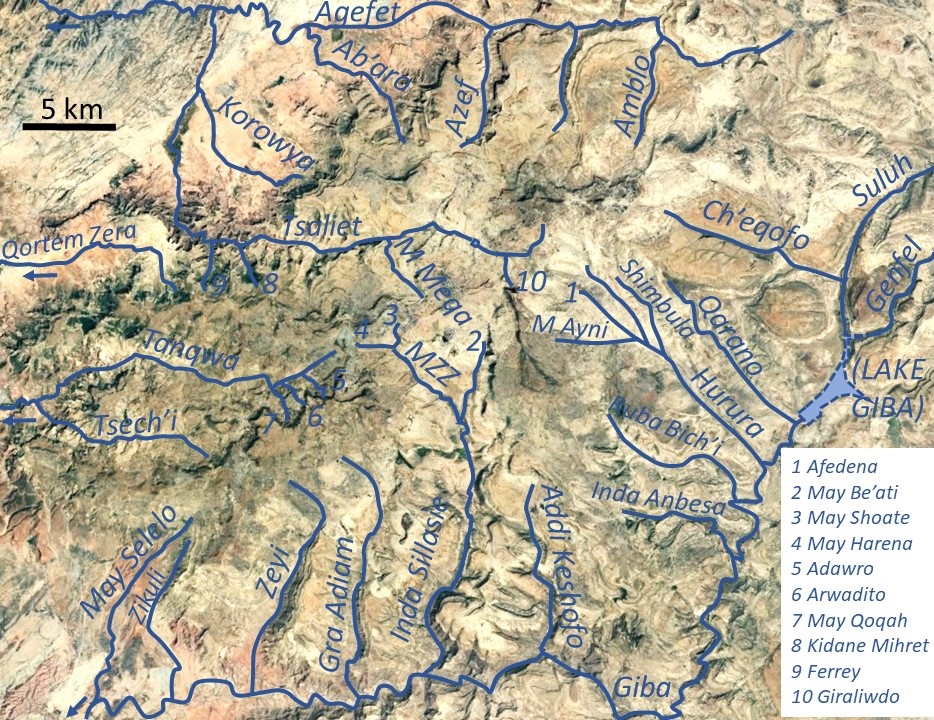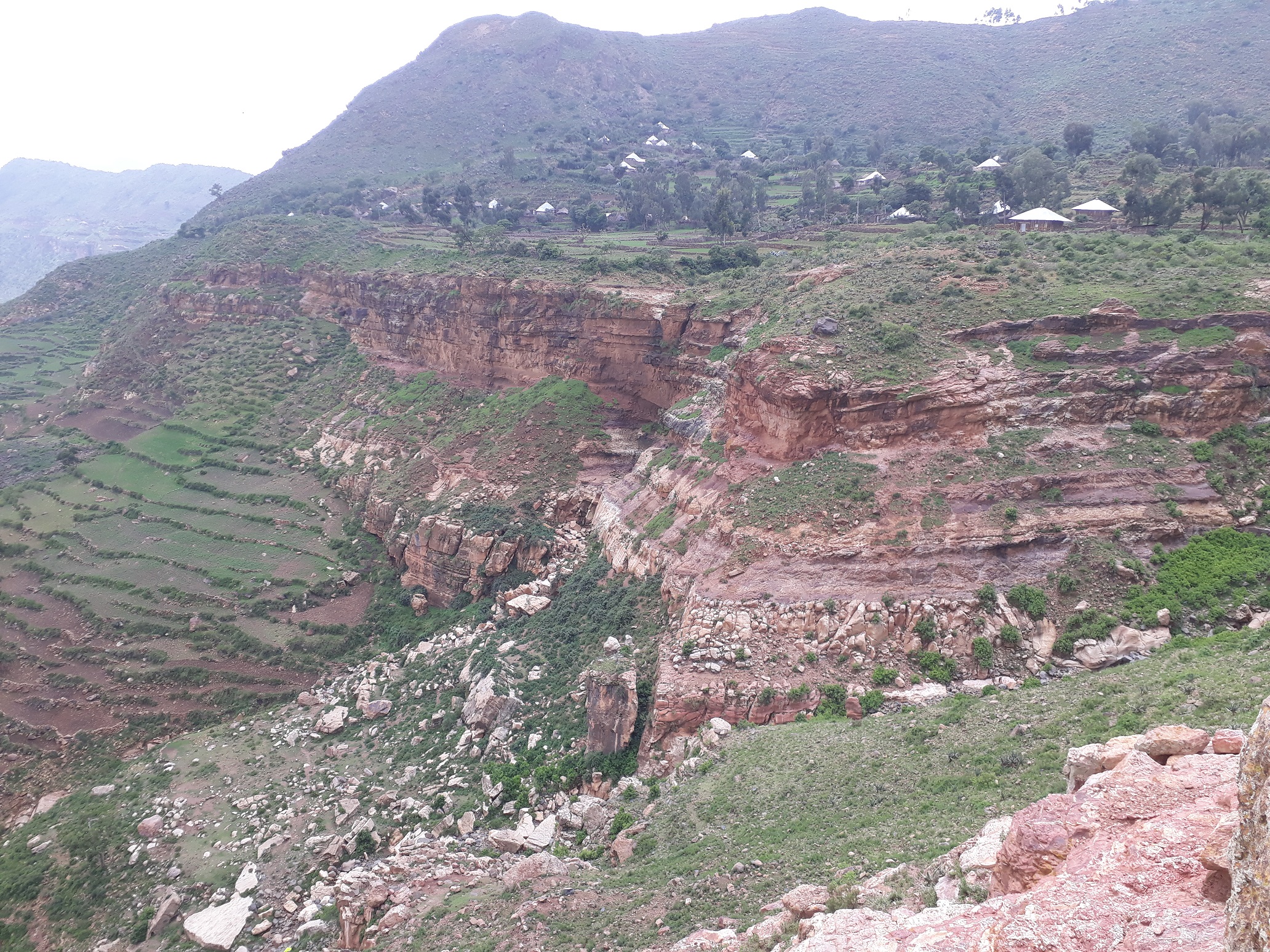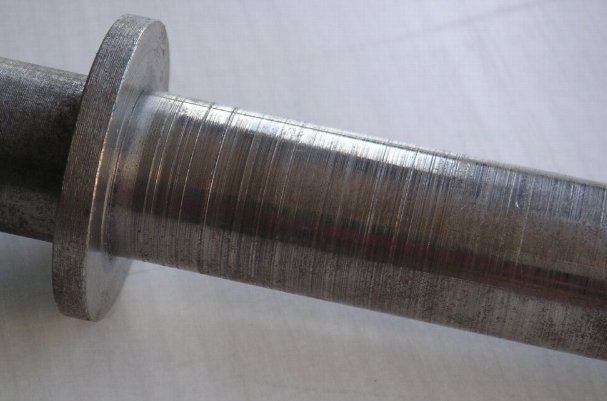|
May Qoqah
May Qoqah is a river of the Nile basin. Rising on the Ts’ats’en plateau of Dogu’a Tembien in northern Ethiopia, it flows northward to empty finally in Giba and Tekezé River. Characteristics It is a confined bedrock river, with an average slope gradient of 90 metres per kilometre. The river has cut a gorge in the surrounding basalt. Flash floods and flood buffering Runoff mostly happens in the form of high runoff discharge events that occur in a very short period (called flash floods). These are related to the steep topography, often little vegetation cover and intense convective rainfall. The peaks of such flash floods have often a 50 to 100 times larger discharge than the preceding baseflow. The magnitude of floods in this river has however been decreased due to interventions in the catchment. Physical conservation structures such as stone bunds and check dams also intercept runoff. Observing that, in rivers with coarse bedload, gabion check dams were destroyed by ... [...More Info...] [...Related Items...] OR: [Wikipedia] [Google] [Baidu] |
Hamute
Lim’at is a '' tabia'' in the Dogu'a Tembien district of the Tigray Region of Ethiopia. The ''tabia'' centre is in Maygwa village, located approximately 8 km to the southwest of the ''woreda'' town Hagere Selam. Geography The ''tabia'' stretches down from the Tsatsen plateau (2810 m a.s.l.), across the main road towards Zeleqwa (Upper Tanqwa) river (2270 m a.s.l.). Geology From the higher to the lower locations, the following geological formations are present: * Upper basalt * Interbedded lacustrine deposits * Lower basalt * Amba Aradam Formation * Antalo Limestone * Quaternary alluvium and freshwater tufa Geomorphology and soils The main geomorphic unit is the Hagere Selam Highlands. Corresponding soil types are: * Associated soil types ** shallow soils with high stone contents (Skeletic Cambisol, Leptic Cambisol, Skeletic Regosol) ** moderately deep dark stony clays with good natural fertility (Vertic Cambisol) ** deep, dark cracking clays, tempora ... [...More Info...] [...Related Items...] OR: [Wikipedia] [Google] [Baidu] |
Check Dam
A steel check dam A check dam is a small, sometimes temporary, dam constructed across a swale, drainage ditch, or waterway to counteract erosion by reducing water flow velocity. Check dams themselves are not a type of new technology; rather, they are an ancient technique dating from the second century A.D. Check dams are typically, though not always, implemented in a system of several dams situated at regular intervals across the area of interest. Function A check dam placed in the ditch, swale, or channel interrupts the flow of water and flattens the gradient of the channel, thereby reducing the velocity. In turn, this obstruction induces infiltration and reduces eroding. They can be used not only to slow flow velocity but also to distribute flows across a swale to avoid preferential paths and guide flows toward vegetation. Although some sedimentation may result behind the dam, check dams do not primarily function as sediment-trapping devices. For instance, on the Gra ... [...More Info...] [...Related Items...] OR: [Wikipedia] [Google] [Baidu] |
Rivers Of Ethiopia
This is a list of streams and rivers in Ethiopia, arranged geographically by drainage basin. There is an alphabetic list at the end of this article. Flowing into the Mediterranean *''Nile (Egypt, Sudan)'' Atbarah River * Mareb River (or Gash River) (only reaches the Atbarah in times of flood) ** Obel River * Tekezé River (or Takkaze or Setit) **Zarima River ** Ataba River ** Wari River *** Qortem Zer'a *** Tsaliet **** Agefet ***** Ab'aro ***** Azef River ***** Amblo **** Korowya **** Ferrey River **** Kidane Mihret River **** May Meqa **** Graliwdo ** Giba River *** Tanqwa **** Tsech'i River **** May Qoqah **** Arwadito **** Adawro River *** May Selelo *** Zikuli River *** Gra Adiam River, also called Bitchoqo River *** Zeyi River *** Inda Sillasie River **** May Zegzeg ***** May Harena ***** May Sho'ate **** May Be'ati River *** Addi Keshofo River *** May Gabat *** Inda Anbesa *** Ruba Bich'i River *** Hurura **** Afedena River ***** May Ay ... [...More Info...] [...Related Items...] OR: [Wikipedia] [Google] [Baidu] |
Amba Aradam Formation
The Amba Aradam Formation is a Cretaceous sandstone formation in Ethiopia. It is up to 200 metres thick, for instance in the Degua Tembien district. As fossils are absent, the age of the Amba Aradam Formation was interpreted based on the age of assumed corresponding sandstones elsewhere in Ethiopia: the Debre Libanos Sandstones in the Blue Nile Basin, and the Upper Sandstone near Harrar in southeast Ethiopia, both of Late Cretaceous age (100–66 million years ago). The lithology of the Amba Aradam Formation makes it less suitable for rock church excavation; caves have however been blasted in this formation to serve as headquarters for the TPLF during the Ethiopian Civil War of the 1980s. Name and definition The name “Amba Aradam Sandstone” was coined by geologist William Thomas Blanford, who accompanied the British invading army in 1868. The formation is named after the Amba Aradam mountain, where the formation widely outcrops. So far the nomenclature was not proposed for ... [...More Info...] [...Related Items...] OR: [Wikipedia] [Google] [Baidu] |
Ashangi Basalts
The Ashangi Basalts are the earliest Tertiary volcanic rocks in north Ethiopia, hence they are in the lowest position. These dark porphyritic basalts are separated from the Mesozoic formations below it by basal conglomerates. The basalts hold phenocrysts that developed before the magma reached the earth surface. These basalts are weathered, partially eroded and have a sub-horizontal stratification, particularly at the lower part. This series was created during the first period of the flood basalt eruptions in north Ethiopia, in the Oligocene. Name and definition The name was coined by geologist William Thomas Blanford, who accompanied the British Expedition to Abyssinia in 1868,{{cite book , last1=Blanford , first1=W.T. , title=Observations on the geology and zoology of Abyssinia, made during the progress of the British expedition to that country in 1867-68 , url=https://archive.org/details/cu31924024736666 , date=1870 , publisher=Macmillan and Co. , location=London after Lake Ha ... [...More Info...] [...Related Items...] OR: [Wikipedia] [Google] [Baidu] |
Intra-volcanic Sedimentary Rock In North Ethiopia
Between 29 and 27 million years ago, the extrusion of Ethiopia’s flood basalts was interrupted and deposition of continental sediments occurred. Inter-trappean beds outcrop in many places of the Ethiopian highlands. They consist of fluvio-lacustrine deposits, that are generally a few tens of metres thick. Often, these interbedded fluvio-lacustrine deposits are very visible because their bright colours strongly contrast with the basalt environment. Name and definition The formation, also called ''silicified limestone'' and ''interbedded lacustrine deposits'' was first extensively characterised in the 1930s by Merla and Minucci. Stratigraphic context The formation is generally at the interface between the lower Ashangi Basalts, and the upper Alaji Basalts. Environment The sediments were deposited in shallow lakes and marshes in large topographic depressions. The dense vegetation hosted mammals and birds, which found their food between the reeds of the lake shores. The decompos ... [...More Info...] [...Related Items...] OR: [Wikipedia] [Google] [Baidu] |
Alaji Basalts
The Alaji (upper) Basalts are the youngest series of the Ethiopian flood basalts. The most recent flows are only 15 million years old. Name and definition The name was coined by geologist William Thomas Blanford, who accompanied the British Expedition to Abyssinia in 1868, after the Imba Alaje mountain. So far the nomenclature has not been proposed for recognition to the International Commission on Stratigraphy. Stratigraphic context Uppermost Tertiary flood basalts in Ethiopia. Locally they are covered by Pliocene shield volcanoes, such as the Simien Mountains, or Mount Guna. These flows have been deposited on the lower Ashangi Basalts and locally on intra-volcanic sedimentary rock. Environment Like all volcanic rocks, the Alaji Basalts originate from initial melting of the Earth's mantle. After extrusion, the magmatic structures form at the surface. Common volcanic structures such as lava tubes or ropy lavas are absent in the Alaji Basalts, but ( columnar joints) are omnipr ... [...More Info...] [...Related Items...] OR: [Wikipedia] [Google] [Baidu] |
Irrigation
Irrigation (also referred to as watering) is the practice of applying controlled amounts of water to land to help grow crops, landscape plants, and lawns. Irrigation has been a key aspect of agriculture for over 5,000 years and has been developed by many cultures around the world. Irrigation helps to grow crops, maintain landscapes, and revegetate disturbed soils in dry areas and during times of below-average rainfall. In addition to these uses, irrigation is also employed to protect crops from frost, suppress weed growth in grain fields, and prevent soil consolidation. It is also used to cool livestock, reduce dust, dispose of sewage, and support mining operations. Drainage, which involves the removal of surface and sub-surface water from a given location, is often studied in conjunction with irrigation. There are several methods of irrigation that differ in how water is supplied to plants. Surface irrigation, also known as gravity irrigation, is the oldest form of i ... [...More Info...] [...Related Items...] OR: [Wikipedia] [Google] [Baidu] |
Strahler Number
In mathematics, the Strahler number or Horton–Strahler number of a mathematical tree is a numerical measure of its branching complexity. These numbers were first developed in hydrology by and ; in this application, they are referred to as the Strahler stream order and are used to define stream size based on a hierarchy of tributaries. They also arise in the analysis of L-systems and of hierarchical biological structures such as (biological) trees and animal respiratory and circulatory systems, in register allocation for compilation of high-level programming languages and in the analysis of social networks. Alternative stream ordering systems have been developed by Shreve and Hodgkinson et al.Hodgkinson, J.H., McLoughlin, S. & Cox, M.E. 2006. The influence of structural grain on drainage in a metamorphic sub-catchment: Laceys Creek, southeast Queensland, Australia. Geomorphology, 81: 394–407. A statistical comparison of Strahler and Shreve systems, together with an analysis ... [...More Info...] [...Related Items...] OR: [Wikipedia] [Google] [Baidu] |
Abrasion (mechanical)
Abrasion is the process of scuffing, scratching, wearing down, marring, or rubbing away. It can be intentionally imposed in a controlled process using an abrasive. Abrasion can be an undesirable effect of exposure to normal use or exposure to the elements. In stone shaping Ancient artists, working in stone, used abrasion to create sculptures. The artist selected dense stones like carbonite and emery and rubbed them consistently against comparatively softer stones like limestone and granite. The artist used different sizes and shapes of abrasives, or turned them in various ways as they rubbed, to create effects on the softer stone's surface. Water was continuously poured over the surface to carry away particles. Abrasive technique in stone shaping was a long, tedious process that, with patience, resulted in eternal works of art in stone. Models The Archard equation is a simple model used to describe sliding wear and is based on the theory of asperity contact. Q = \frac H wher ... [...More Info...] [...Related Items...] OR: [Wikipedia] [Google] [Baidu] |








